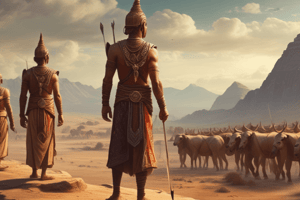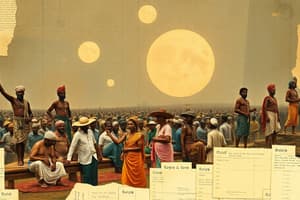Podcast
Questions and Answers
What event is believed to have led to the decline of the Harappan civilization?
What event is believed to have led to the decline of the Harappan civilization?
- Trade collapse
- Aryan migration
- Natural disasters
- Overpopulation in Central Asia (correct)
The early Vedic civilization began around 1500 BCE.
The early Vedic civilization began around 1500 BCE.
True (A)
Name the four main Vedas.
Name the four main Vedas.
Rigveda, Samaveda, Yajurveda, Atharvaveda
The region referred to as Aryavarta encompasses the _____ basin.
The region referred to as Aryavarta encompasses the _____ basin.
Match the following Vedic society roles with their responsibilities:
Match the following Vedic society roles with their responsibilities:
What method was primarily used for passing down Vedic teachings before writing?
What method was primarily used for passing down Vedic teachings before writing?
Janapadas were large political units formed by tribes in Vedic society.
Janapadas were large political units formed by tribes in Vedic society.
The seven rivers defining the Sapta Sindhu region are Jhelum, Chenab, Ravi, Beas, Sutlej, Indus, and ______.
The seven rivers defining the Sapta Sindhu region are Jhelum, Chenab, Ravi, Beas, Sutlej, Indus, and ______.
What agricultural products were primarily part of the diet in early Vedic civilization?
What agricultural products were primarily part of the diet in early Vedic civilization?
Women had limited autonomy in choosing their marriage partners during the early Vedic period.
Women had limited autonomy in choosing their marriage partners during the early Vedic period.
Name one economic activity that supported livelihoods in the early Vedic civilization.
Name one economic activity that supported livelihoods in the early Vedic civilization.
The presence of women was essential in ______ ceremonies during the early Vedic period.
The presence of women was essential in ______ ceremonies during the early Vedic period.
Match the following aspects of early Vedic civilization with their descriptions:
Match the following aspects of early Vedic civilization with their descriptions:
What types of activities were popular for entertainment in early Vedic society?
What types of activities were popular for entertainment in early Vedic society?
The early Vedic civilization had a diverse culinary culture.
The early Vedic civilization had a diverse culinary culture.
What was the primary focus of worship in early Vedic religious beliefs?
What was the primary focus of worship in early Vedic religious beliefs?
Flashcards are hidden until you start studying
Study Notes
Early Vedic Civilization
- Early Vedic civilization developed after the decline of Harappan civilization around 1500 BCE.
- Aryans, believed to have migrated from Central Asia, were key to the flourishing of early Vedic civilization.
- Migration theories include conflict and overpopulation in Central Asia as reasons for Aryan movement to India.
- Settled primarily in the Sapta Sindhu region, defined by the seven rivers: Jhelum, Chenab, Ravi, Beas, Sutlej, Indus, and Saraswati.
Timeline and Phases
- Early Vedic period spans from 1500 BCE to 1000 BCE, based primarily on the Rigveda.
- The later Vedic period ranges from 1000 BCE to 500 BCE, reflecting further social and political developments.
- The region is referred to as Aryavarta (Land of the Aryans), encompassing the Ganges basin.
Vedic Literature
- Vedic texts are religious and cultural knowledge sources, primarily called the Vedas, which means "knowledge" in Sanskrit.
- Four main Vedas: Rigveda, Samaveda, Yajurveda, and Atharvaveda.
- Vedas contain teachings, hymns, rituals, and social norms important to Aryan society.
- Oral tradition preceded written texts, with teachings passed down generations before being recorded in manuscripts.
Political Organization
- Society was organized into tribes, with small villages forming larger political units known as janapadas.
- Political leaders, known as rajas, emerged based on ability and public consent rather than inheritance.
- Councils called Sabha and Samiti were formed, allowing public participation in decision-making.
- Officials assisted the raja, including religious leaders (puruhita) and military leaders (senani).
Social Structure
- Villages reflected a rural lifestyle, unlike the urban focus of the Harappan civilization.
- Families were often joint, with a significant focus on community relationships and respect.
- The grihapati (head of the family) held decision-making authority within the family structure.
- Women participated actively in society, holding essential rights and opportunities for education and scholarships.
Economic Life
- Agriculture formed the base of the economy, with cattle herding and trade also prominent.
- Communities engaged in various economic activities, essential for supporting their livelihoods.
Conclusion
- The early Vedic civilization laid the foundations for later Indian cultural, political, and social structures, influencing subsequent historical developments significantly.### Mandatory Presence of Women in Religious Ceremonies
- Presence of women was essential in religious ceremonies; without it, rituals couldn't start or be deemed complete.
- Women's role during ceremonies highlights their significant position in society during Vedic times.
Marriage Customs
- Women had the autonomy to choose their partners through practices like swayamvara, indicative of a progressive view on marriage.
- Child marriage was not prevalent during this period; it emerged in later historical contexts.
Social Status of Widows
- Widows were allowed to remarry, showcasing a more liberal social structure compared to later eras.
- The position of women was generally respected in various social settings.
Diet and Nutrition
- Diet consisted of simple and nutritious foods including barley, grains, fruits, and vegetables, along with milk and dairy products.
- Honey and intoxicating drinks like soma were also part of the diet, highlighting a diverse culinary culture.
Entertainment Activities
- Outdoor activities like horse riding, hunting, and chariot racing were popular.
- Music and dance were enjoyed, alongside board games, indicating a well-rounded approach to leisure.
Clothing
- Men typically wore dhotis (lower garment) and turbans as headwear.
- Both men and women adorned themselves with jewelry made of gold, silver, and precious stones.
Religious Beliefs
- Worship focused on one supreme power believed to have created the universe; nature forces were also revered.
- Deities included Indra (god of rain and thunder), Agni (fire), Surya (sun), and others, reflecting a nature-centered belief system.
Forms of Worship
- Rituals were conducted openly, often in nature without idols or temples initially.
- Offerings to deities were integral to prayers for health, prosperity, and agricultural success.
Class System and Social Structure
- Society was organized based on occupation, leading to the formation of the four varnas: Brahmins (priests), Kshatriyas (warriors), Vaishyas (merchants), and Shudras (laborers).
- Social mobility existed; individuals could change their varna based on their profession rather than birth.
Economic Life
- Early Aryans transitioned from nomadic tribes to settled agricultural communities.
- Knowledge of agriculture and seasonal impacts was advanced; various artisans engaged in crafts, as recorded in the Rigveda.
- Villages were self-sufficient, producing their own goods and crafts.
Summary
- Vedic civilization exhibited an evolved social structure with significant roles for women, diverse dietary practices, and an appreciation for nature in religion and entertainment. Over time, societal norms shifted, particularly regarding marriage and social class divisions.
Early Vedic Civilization
- Emerged around 1500 BCE after the decline of the Harappan civilization.
- Aryans migrated from Central Asia, contributing significantly to the civilization's development.
- Migration theories suggest causes such as conflict and overpopulation in Central Asia.
- Settlements primarily located in the Sapta Sindhu region, defined by seven key rivers: Jhelum, Chenab, Ravi, Beas, Sutlej, Indus, and Saraswati.
Timeline and Phases
- Early Vedic period: 1500 BCE to 1000 BCE, primarily based on the Rigveda.
- Later Vedic period: 1000 BCE to 500 BCE, marked by further developments in society and politics.
- The region was called Aryavarta, meaning "Land of the Aryans," primarily located in the Ganges basin.
Vedic Literature
- Vedic texts, known as the Vedas, are foundational religious and cultural documents, meaning "knowledge" in Sanskrit.
- Four main Vedas: Rigveda, Samaveda, Yajurveda, and Atharvaveda, each containing hymns, rituals, and teachings for society.
- The oral tradition preceded written texts, with knowledge being passed down generations before being documented.
Political Organization
- Society was arranged into tribes, with janapadas as larger political units.
- Political leadership emerged with rajas, chosen for ability and public consent rather than through hereditary lines.
- Institutions like Sabha and Samiti were established for public participation in governance.
- Key officials included puruhita (religious leaders) and senani (military leaders) who supported the raja.
Social Structure
- Villages exhibited a rural lifestyle, contrasting with the urban centers of the Harappan civilization.
- Joint families were common, emphasizing community ties and respect.
- The grihapati, or family head, wielded decision-making power within households.
- Women were actively involved in society, enjoying rights to education and opportunities in various fields.
Economic Life
- The economy was predominantly agricultural, supplemented by cattle herding and trade.
- Diverse economic activities supported community livelihoods, reflecting a robust economic system.
Conclusion
- Early Vedic civilization significantly influenced later Indian cultural, political, and social frameworks.
Mandatory Presence of Women in Religious Ceremonies
- Women's presence was crucial for the initiation and completion of religious rituals, highlighting their societal importance.
Marriage Customs
- Women had the right to choose partners through practices like swayamvara, indicating progressive marriage views.
- Child marriage was not a prevalent custom during this era; its rise occurred later.
Social Status of Widows
- Widows could remarry, suggesting a more liberal social structure compared to subsequent periods.
- The general respect for women’s positions was evident across various social contexts.
Diet and Nutrition
- Common diet included barley, grains, fruits, vegetables, and dairy products, ensuring nutritional balance.
- Honey and intoxicating drinks like soma were also consumed, showcasing a diverse culinary tradition.
Entertainment Activities
- Popular leisure activities included horse riding, hunting, and chariot racing.
- Music, dance, and board games were also enjoyed, reflecting a well-rounded view of entertainment.
Clothing
- Men typically wore dhotis and turbans as headgear.
- Both genders adorned themselves with jewelry crafted from gold, silver, and precious stones.
Religious Beliefs
- Worship centered around a single supreme power believed to be the universe's creator, with reverence for natural forces.
Studying That Suits You
Use AI to generate personalized quizzes and flashcards to suit your learning preferences.




